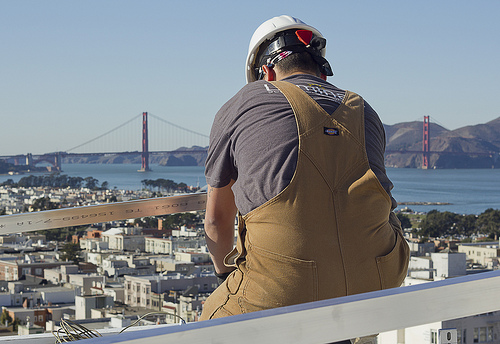Solar Pro Magazine, a technical publication of the solar industry, recently interviewed David Green, veteran senior electrical inspector for the City and County of San Francisco. With his vast experiences inspecting all solar electric systems installed in San Francisco over the past 11 years, David Green advocates that San Francisco homeowners and businesses looking to install solar find a contractor that has years of specific experience working with San Francisco’s unique buildings, is NABCEP Certified, and has a proven dedication to craftsmanship and safety. In addition, he mentions the benefits of choosing a contractor that holds specialized licenses (including C-46 Solar, C-10 Electrical – Luminalt holds 3 specialized licenses in addition to a B-General)

Important Resources: When hiring a solar contractor to install on your San Francisco home or business, it’s important to make sure that you research their certifications and experience. Here we list a few great resources to aid in your due diligence:
- Has your solar installer done many solar installations in San Francisco? Check out the San Francisco Solar Map to explore the installations in your neighborhood. As David Green mentions in the article below, San Francisco homes tend to be unique – installers that rely on cookie cutter solar designs will not give you the best designed system. At Luminalt, we custom design all of our systems with in-house engineers to ensure your solar investment is protected.
- Does your solar contractor have a specialty license for solar (C-46) and electric (C-10) from the California State License Board? Do they have any violations on their license? You can look up a company by name on the California State License Board’s License Checker website.
- Will your solar system installation be supervised on-site at all times by someone holding NABCEP Certification? To become a NABCEP Certified solar installer, an individual must have several years of industry experience, pass an exam with a pass rate lower than the California Bar Exam, and take continuing education courses. Luminalt has numerous NABCEP Certified employees in installation, sales, and design to ensure that each and every system we install is top knotch.
Read on for the full interview with Solar Pro Magazine:
David Green has served as an electrical inspector and senior electrical inspector for the City and County of San Francisco Department of Building Inspection for 22 years. Previously he worked for electrical contractors in San Francisco as an inside wireman, foreman and estimator. He is the go-to source for PV technical issues in the City. He has supervised the inspection of all PV systems installed in San Francisco since December 2002. Green is actively involved in advancing the quality of solar inspections and best practices through his daily work with the City. He is certified by the International Association of Electrical Inspectors as an electrical inspector and plan reviewer, and he teaches inside wiremen apprentices and journeypersons.
SP: When did you first start seeing permitted PV systems in San Francisco? How did you and your team of electrical inspectors become familiar with PV technology then and how have you continued that education over the years?
DG: The Department started reviewing and inspecting PV system installations in 2002. A total of four systems were installed and inspected in December of that year. Starting at that time, our inspectors began taking PV courses, but inspectors and installers also had to learn on the job. We continue to send inspectors to many of the PV courses available in the Bay Area, and we regularly discuss PV issues at our biweekly division technical meetings.
SP: What current and future challenges do you see for inspectors and AHJs to do their part in ensuring safe PV systems? Do you have enough resources?
DG: Adequate staffing is always an issue, and the problem is not limited to inspecting PV systems. However, except during the worst of the recent economic crisis, the Department has allocated adequate funds for training, and the Electrical Inspection Division has considered PV education a high priority. We welcome short presentations by manufacturers of new products as they become available.
SP: Have you seen any encouraging trends in PV system design and installation practices?
DG: Personally, I hope that ac modules become more cost effective and widely available. I believe they have the potential to reduce the hazard to first responders.
SP: Have you seen any disturbing trends in system design and installation practices?
DG: No. Over time, the knowledge and experience of both inspectors and installers have improved.
SP: Have you seen a proliferation of module-level electronics, such as microinverters and DC optimizing devices, in PV installations?
DG: Although we do not track this, microinverters are deployed in a significant percentage of the installations I review. I occasionally review systems that utilize DC optimizers.
SP: The US market seems to be learning from Europe and heading toward more ungrounded systems that operate at higher voltages. From a safety and enforcement point of view, is this a good thing?
DG: I have reviewed one system with ungrounded DC input to the inverter, and have discussed the differences with staff. I have no opinion on the relative safety of ungrounded versus grounded systems, but I do consider higher voltages to present a greater risk of shock and electrocution whether or not they are grounded.
SP: What steps has San Francisco taken to streamline or improve the solar permitting process over the years? What steps are you considering for the future? What would you recommend to other cities and AHJs?
DG: At the request of and with the participation of the active PV contractors at the time, the Department developed and instituted a permit and inspection procedure that waives the requirement for building permits, formal structural plan review and inspection by building inspectors, and provides permit applicants certified compliance with a specific list of installation requirements. A single inspection and approval by an electrical inspector completes the process. This procedure is still in force and saves installers significant permit fees and plan review time. Systems with array capacities of 4 kW and under do not require review, and we attempt to perform an over-the-counter review for larger systems if electrical inspection staff are available. Approximately 90% of permits are reviewed within 2 days of receipt. We currently enable C-10 and C-46 contractors to obtain permits online for systems 4 kW and under.
SP: An expensive challenge for system installers is adapting their designs and installation methods to the differing requirements of various AHJs, including fire marshals. From the perspective of streamlining the solar installation process and reducing total installed costs, it would be helpful if all AHJs used the same code and the same plan-checking criteria. Is there anything the industry can do to help standardize these requirements?
DG: San Francisco has a small number of amendments to California Electrical Code Article 690 that are justified by topography and climate. Interpretations can differ among jurisdictions, and we do have AHJs respond to changes in the industry and develop procedures as best they can. Changes to developed procedures require agreement from the building and fire departments, contractors and the general public. In San Francisco, PV installation contractors can lobby the Building Inspection and Fire Department Commissions to make desired improvements, such as instituting the expedited permit process developed by SolarABCs and Bill Brooks. I have no objection to this, but making such changes requires the Department to commit time and resources, and this cost must be balanced against the benefit.
SP: Do you see different levels of quality in design or installation from different categories of contractors? Residential versus commercial? NABCEP-certified installers?
DG: Yes. Contractors who have not done work in San Francisco sometimes have difficulty dealing with our larger buildings, dense lot build-out, high fault current, point of connection to large services and tap-conductor requirements. A recent example is a contractor who installed wiring from the roof to the ground floor inside the exit stair enclosure, which is a violation of the California Building Code.
SP: Veteran PV industry experts are concerned about increases in PV-initiated fires, especially on rooftops. Ground faults and other arcing faults seem to be the primary cause for these concerns. Section 690.11 of the 2011 NEC requires series arc-fault protection in DC PV circuits, and the 2014 NEC will likely require both series and parallel arc-fault protection. Are these requirements sufficient?
DG: The 2011 NEC will not be enacted into law in California until January 2014. If solar industry experts are concerned, they should implement these protections voluntarily or lobby for interim code changes. Failures and fires caused by PV systems are not reported directly to me. I do have secondhand knowledge of a fire in a 100 kW inverter, but I was told it was due to reverse polarity wiring that all concerned failed to detect. Although I am in favor of such safety improvements, the Department would require documentation of hazard and support from industry and interested citizens to require early enforcement.

